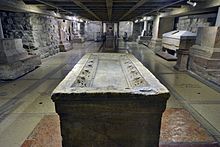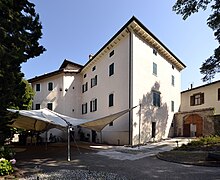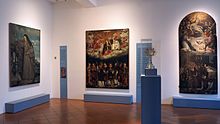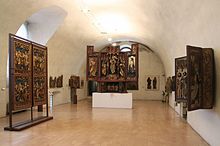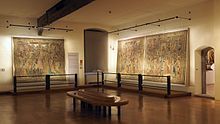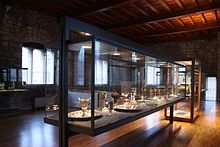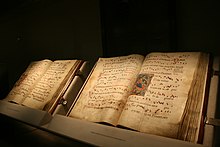Tridentine Diocesan Museum
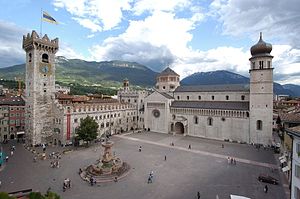 The Tridentine Diocesan Museum with the cathedral |
|
| Data | |
|---|---|
| place | Piazza Duomo, 18, Trient , Italy |
| Art | |
| opening | 1903 |
| operator | |
| management |
Domenica Primerano
|
| Website | |
The Tridentine Diocesan Museum ( Italian museo diocesano tridentino ) is a diocesan museum in Trento ( Italy ). It is located in the rooms of Palazzo Pretorio , the first episcopal residence built next to the Cathedral of San Vigilio in the heart of Trento. In its rooms there is a rich heritage of art and culture, dating from the 11th to the 19th centuries, coming from the churches of Trentino . The museum tour is enriched by an impressive passage, which makes it possible to see the nearby cathedral from above and to visit the archaeological space of the Porta Veronensis.
history
The museum was founded in 1903 to preserve the artistic heritage of the diocese and to make it available to the School of Art and Christian Archeology of the Theological Seminary for didactic purposes. The collection was only housed in the Seminario Minore. A military hospital was moved to this building during the First World War , which is why the collection had to be removed and placed in the sacristy of the cathedral and other ancillary rooms. It was not until 1963, on the four hundredth anniversary of the Council of Trento , that the museum was given a permanent location next to the Cathedral of San Vigilio , namely in the Palazzo Pretorio, the old residence of the Bishops of Trento . In the 1990s the building was extensively restored and the collection was organized and exhibited according to modern museum criteria. In 1995 Pope John Paul II officially opened the redesigned museum.
Premises
In addition to the headquarters in Palazzo Pretorio on the Piazza Duomo in Trento, the management of the Diocesan Museum is also responsible for the excavated “Early Christian Basilica of San Vigilio” in the cathedral right next to the museum and an adjoining seat in Villa Lagarina near Rovereto .
Palazzo Pretorio
The building in which the Tridentine Diocesan Museum is located, commonly referred to as the Pretorio Palace, was the high medieval residence of the Bishops of Trento. In the short period between the 9th and 10th centuries, the cemetery sanctuary of San Vigilio took on the function of a city cathedral, which was previously performed by an ecclesia intra civitatem (according to Passio Sancti Vigilii ) in the area of the Church of Santa Maria Maggiore . At that time, the episcopal residence was moved from its old seat to the area between the remains of the Porta Veronensis and the face of the Vigilius Basilica: the Palatium Episcopatus was built here, with its own chapel dedicated to St. Blaise and St. Lucia . The building reportedly consisted of a series of walled houses and courtyards. Around 1255 Egno von Eppan moved the bishop's residence to the fortress of Buonconsiglio . Thus began the gradual abandonment of the old Palatium episcopatus , which was partially used as the seat of the Court of Justice and the Praetor. In 1533 Cristoforo Madruzzo ceded the part in Piazza Torre to the pawnshop, which in turn made the second floor available to the consuls of the city and the medical college. In 1676, Prince-Bishop Sigismondo Alfonso Thun promoted the restoration of the building and unified the facade, which lost the original Romanesque design, which was only restored after a radical restoration in the 1950s. Since 1963 the palace has been used as the permanent seat of the Diocesan Museum.
Basilica paleocristiana
Between 1964 and 1977 excavations under the Cathedral of San Vigilio discovered the remains of the early Christian Basilica of San Vigilio, which was built outside the Roman city walls, probably towards the end of the 4th century. The building owes its origin to the burial of Saints Sisinnius, Martyrius and Alexander, who were killed by the pagans on May 29, 397 in the Non Valley . A few years later, in addition to the three martyrs, Vigilius, the third bishop and patron saint of Trent, was buried. The late antique cult site, which originally served as a cemetery basilica or a pilgrimage church with a memorial function, became a cathedral between the 9th and 10th centuries when the bishop's palace was relocated to its immediate vicinity. Over the centuries the church has undergone some significant structural changes: in the 9th century, two side chambers were added, in the 11th century the hall was divided into three aisles and a crypt with an ascent to the presbytery was built. The last interventions were carried out by Bishop Altemanno, who consecrated this church on November 18, 1145. It was supposed to be replaced by today's cathedral as early as the 13th century. In the middle of the huge hall is the famous “Arch of San Vigilio” (11th-12th centuries), a special type of funerary monument that in the past contained the remains of the city's patron.
This archaeological excavation site - the archaeological excavations took place between 1964 and 1977 - is subordinate to the Diocesan Museum, but is only accessible from the cathedral.
Villa Lagarina next door
In consultation with the parish and parish of Villa Lagarina , the Diocesan Museum in Trentino took care of the enhancement and presentation of the valuable artistic and liturgical heritage associated with the parish church of Santa Maria Assunta and the prelates of the Lodron family who worked there. They built their own branch in the rooms of the Palazzo Libera, which dates from the 18th century. The tour includes a collection of valuable works of art and ecclesiastical furnishings that were created for the Lodron family. The aristocratic family had the right to exercise church patronage from 1561 to 1804 . The artistic changes in the prestigious church building and the rich offer of valuable sacred furnishings are the result of careful and refined patronage. They made the Church of the Assumption a symbol of the political and religious power of the Counts of Lodron.
Exhibition route
The museum tour in the Diocesan Museum - in its headquarters in the Palazzo Pretorio - is organized according to individual topics. B. the history of the city or that of the Council of Trent presented in individual rooms.
painting
The works featured in this section provide a comprehensive overview of local painting from the Middle Ages to Neoclassicism . The tour shows painters from the cultural centers of the Veneto , the Po Valley and beyond, to whom Trentino painting owes a lot. The museum houses the valuable painting by Giambattista Pittoni depicting St. Dominikus (1730), which was commissioned by Prince Bishop Domenico Antonio Thun (1730–1758) at the beginning of his episcopate. The exhibition is preceded by some paintings illustrating the iconography of the patron saints of the Diocese of Trento: Vigilius of Trento , St. Maxentia and the Martyrs of the Non Valley (Sisinnius, Martyrius and Alexander). In the other halls the works are arranged chronologically, which shows the development of the style of the artist and the taste of the client: The palette ranges from the panels from the time of Prince-Bishop Johannes Hinderbach to the altarpieces of the Renaissance and due to the transalpine artists of the baroque. There are important works by artists from Padua, Veneto and Tyrol; such as B. Francesco Verla, Giovanni Battista Moroni , Martin Teofilo Polacco, Johann Carl Loth , Giuseppe Alberti , Andrea Pozzo , Paul Troger and Francesco Fontebasso .
Wooden sculptures
This section shows valuable works and fragments of altars from the 15th and 16th centuries: this period comprises the most significant and valuable core of the museum collections in terms of quantity, which shows an almost uniform quality. Sculpture production developed at this time in two approaches, each with characteristic features, one being connected with the Po Valley and the other with German and Tyrolean culture. These different forms of expression are illustrated by the example of the polyptych from the parish church Avio and the numerous winged altars from the churches of the diocese, which were made by well-known South Tyrolean carvers such as master Narziss and Jörg Arzt, both from Bozen . The section ends with an emphasis on the dialogue that began in the mid-16th century between Lombard (e.g. the Olivieri brothers) and Tyrolean carvers when their respective artistic expressions changed.
Tapestries and textiles
The collection of liturgical vestments in the Diocesan Museum is made up of two parts, on the one hand pieces from the Cathedral of San Vigilio and on the other hand pieces from the churches of the diocese from the 15th to the 19th century. The collection is so extensive, varied and of high quality that it is possible not only to sketch the development of textile art (if only for important episodes), but also to make a direct comparison between the very valuable fabrics of the cathedral and those of the churches of the To employ in the diocesan territory.
The collection also includes tapestries with scenes of the Passion of Christ, which were acquired in Antwerp in 1531 by Prince-Bishop Bernhard von Cles (1514–1539). Originally made to decorate the Tower of Sopra, in the residence of the Castello del Buonconsiglio , they served as a valuable decoration of the council chamber installed in the choir of the cathedral on the occasion of the Council of Trento. The cycle, described by art critics as “extraordinary and perhaps unique in Italy”, was created in Brussels in the studio of Pieter van Aelst, one of the most important tapestry designers of his time.
The cathedral treasure
The history of the Cathedral of Trento has been reflected in its treasure since the 12th century, which has survived to the present day. It is so valuable not only because of the high quality and importance of many objects, but also because of the large number. The exhibition follows a chronological course from the Middle Ages to the 19th century . In the center is the silver processional shrine of St. Vigilius , which was created for the cathedral in 1632 and modified around 1760. With different pieces, i.e. through their form, function and style, the diverse orientations of goldsmithing in the Alpine region and the privileged relationships with famous centers such as Nuremberg are presented. Separate safekeeping was reserved for the reliquaries. The section ends with an altar shrine in which the various sacred implements necessary for the celebration of the mass are set up.
Next to this section is one of the most noticeable donations made by Georg von Liechtenstein (1390–1419), a nobleman from Moravia , who became Bishop of Trento in 1390 after serving as provost of St. Stephen's Cathedral in Vienna . The extraordinary collection shows exemplary documents of the highest quality of the international Gothic, which had spread throughout Europe since the middle of the 14th century .
The Illuminated Manuscripts
In the rooms of the old palace tower of the palatium episcopatus , the Torre di Piazza , a small but valuable collection of illuminated manuscripts is on display, most of which come from the library that had been installed in the Cathedral of San Vigilio since the Middle Ages . This also includes the books necessary for liturgical purposes and the volumes of the adjacent library of the cathedral chapter. Particularly noteworthy is the Gregorian mass sacramentary with the antiphonary , which was decorated with miniatures by a southern German artist from the second half of the 11th century.
Visual evidence of the Council of Trent
This section shows some significant iconographic evidence of the Council of Trent . This was officially opened in 1545 and ended after several interruptions in 1563. It was convened by the Catholic side at an extremely delicate moment for Europe. The epoch was shaken by Luther's demands for the Reformation, and the council was supposed to react to them, be it through reform of the church and religious reconciliation (according to the imperial expectation), or through the establishment of Catholic doctrine (according to the papal starting position). The city was chosen as a council location due to its geographical location. It was a fortified city on the main artery connecting the north with Rome, and the seat of a prince-bishop loyal to the pope and emperor.
On the first tour of the stairs you can see the large painting depicting a “General Congregation” of the Council. It shows an everyday encounter of work, information and advice in the Church of Santa Maria Maggiore. The second tour is the collection of paintings that illustrate the solemn sessions in the Cathedral of San Vigilio.
Major works
- Elia Naurizio, Congregazione generale del Concilio di Trento - General Assembly of the Council of Trento , 1633, oil on canvas, 353 × 293 cm
- The painting by the Trentino painter Elia Naurizio (1589–1657) represents a general meeting of the Council of Trent, which was a daily mixture of work, information and advice. From 1562, that is, in the third period of the council, the number of bishops increased considerably until it reached two hundred people. For this reason it was necessary to find a suitable place to accommodate all participants, which was possible in the Church of Santa Maria Maggiore, which is represented here.
- Gli arazzi della Passione - the passion carpets
- The tapestries on display were bought in Antwerp in 1531 by Prince-Bishop Bernhard von Cles (1514–1539), who used them to decorate the tower in the residence of the Castello del Buonconsiglio . On the occasion of the Council of Trent, they were the precious furnishings of the council chamber, which was installed in the choir of the cathedral. The tapestries are part of a cycle of scenes from the Passion of Christ, which is considered “extraordinary and perhaps unique in Italy”. They were made in Brussels in the workshop of Pieter van Aelst, the most important tapestry entrepreneur and producer of his time. The tapestries in Trento belong to a style that is known in art history as pre-Renaissance, as it is characterized by the connection of the Flemish Gothic tradition with the new trends of the Italian Renaissance .
- Giuseppe Alberti , San Vigilio in estasi - Martyrdom of Saint Vigilius , 1674, oil on canvas; 192.5 × 131 cm
- The altarpiece was painted for the private chapel of Prince Bishop Francesco Alberti di Poja in the Castello del Buonconsiglio . In the 19th century it was moved to the cathedral. The painting belongs to the best creative phase of Giuseppe Alberti, one of the most important painters of the Trentino Baroque , who initiated the painting school of the Fiemme Valley . The work depicts the patron saint of the Diocese of Trento in an ecstatic posture, clad in a splendid cope . He is surrounded by several angels, some with the attributes of the saint, others show a picture depicting the alleged martyrdom of the bishop. According to legend, the inhabitants of Val Rendena whom the bishop wanted to convert to Christianity killed him around the year 400.
- Giovan Battista Moroni , Santa Chiara - Saint Clare , 1548, oil on canvas; 183 × 125 cm
- One of the most important works of art in the museum is the painting with Clare of Assisi by Giovan Battista Moroni , Bergamo's most important painter in the 16th century. After an apprenticeship in Brescia in Alessandro Moretto's workshop , he began working as a freelance painter in Trento. The dates coincide with the opening phase of the council. This was a moment when the small capital of the episcopal principality became internationally known and so presented itself as a good opportunity for an artist.
- The altarpiece for the Church of San Michele Arcangelo, which belongs to the Poor Clare Monastery, depicts the monumental figure of Clare resting on a high balustrade. The saint holds a precious monstrance. This illustrates the wonderful episode with the Saracens . who run away. They had besieged Assisi and threatened the nuns' refuge. Although the saint was sick, she had brought the Eucharist to the door of the monastery so that the attackers were forced to withdraw. The episode is presented against the backdrop of a city that may look like Trento.
- The emphasis on the Eucharist can be linked to the debate about the teaching of the Protestants who shaped the work of the Council. The balustrade could also symbolize the firmness of the dogmatic basis of Catholic theology towards the Eucharistic sacrament. The sum of didactic clarity and archaic and strict design make this work a kind of “manifesto of reformed painting”, which corresponds to the demands of that religious, sober and profound sense that shaped the Catholic Reformation .
Temporary exhibitions
- Maternage - Tracce di un viaggio (March 20 - May 23, 2016), installation by Laura Morelli
- Mio dolce paese, dove be? - Mon doux pays, où êtes-vous? (September 9, 2015 - February 29, 2016), curated by D. Primerano and R. Turrina
- Affidarsi al cielo. Arte e devozione a Montagnaga di Piné (April 25 - September 7, 2015), curated by D. Primerano, D. Cattoi, L. Liandru
- Alla stessa mensa, tra rito e quotidianità. Percorsi di riflessione attraverso l'arte (February 6th - April 6th 2015)
- Infinito Presente. Elogio della relazione (June 23 - November 10, 2014), curated by A. Dall'Asta, D. Primerano, R. Turrina
- Arte e persuasione. La strategia delle immagini dopo il concilio di Trento (March 7th - September 29th 2014), curated by D. Cattoi and D. Primerano
- La città e l'archeologia del sacro. Il recupero dell'area di Santa Maria Maggiore (November 29, 2013 - May 25, 2014), curated by MT Guaitoli and E. Lopreite
- La città sottile. Architetture utopiche ideate dai bambini (September 20 - November 18, 2013), curated by A. Panzuto
- Un vescovo, la sua cathedral, il suo tesoro. La committenza artistica di Federico Vanga (1207-1218) (December 14, 2012 - April 7, 2013), curated by M. Collareta and D. Primerano
- L'immagine dell'altro tra stereotipi e pregiudizi. Spunti di riflessione (June 22 - November 26, 2012), curated by D. Cattoi, L. Liandru, D. Primerano
- La Torre di piazza. Funzioni, simboli, immagini (February 24 - May 27, 2012), curated by F. Cagol, G. Gentilini, D. Primerano, in collaboration with L. Liandru and D. Tessarin
- Presepinmuseo (December 3, 2011 - January 9, 2012), curated by D. Primerano
- Una storia a ricamo. La ricomposizione di un raro ciclo boemo di fine Trecento (June 25 - November 28, 2011), curated by D. Primerano
- La Deposizione di Cristo nelle incisioni della Collezione Vescovile (April 8-25 , 2011), curated by D. Primerano
- Guidati da una stella. Il lungo viaggio dei Magi (December 4, 2010 - January 10, 2011), curated by D. Primerano
- “La mia arte io la chiamo mestiere”. Remo Wolf uomo e artista del '900 (July 3 - November 8, 2010), curated by D. Primerano and R. Turrina
- Andrea Pozzo (1642-1709). Pittore e prospettico in Italia settentrionale (December 19, 2009 - April 5, 2010), curated by E. Bianchi, D. Cattoi, G. Dardanello, F. Frangi, coordinamento Domenica Primerano
- Dieci artisti (August 16 - September 30, 2009), curated by D. Primerano
- L'uomo del Concilio. Il Cardinale Giovanni Morone tra Roma e Trento nell'età di Michelangelo (April 4 - July 26, 2009), curated by R. Pancheri and D. Primerano Consulenza storica di Massimo Firpo and Iginio Rogger
- Il Duomo di Trento tra tutela e restauro 1858-2008 (December 20, 2008 - March 15, 2009), curated by D. Primerano and S. Scarrocchia
- Rinascimento e passione per l'antico. Andrea Riccio e il suo tempo (July 5 - November 2, 2008), curated by A. Bacchi, F. De Grammatica and L. Giacomelli
- Gli arredi liturgici di Santa Maria Maggiore (March - June 2008), curated by D. Primerano and D. Cattoi
- Il Natale degli umili della pittura di Leandro Bassano (December 1, 2007 - January 13, 2008), curated by R. Pancheri
- Immagini della Natività dalla collezione vescovile di stampe (December 1, 2007 - January 13, 2008), curated by Domenica Primerano
- Tullio Garbari. Lo sguardo severo della bontà (June 29 - November 4, 2007), curated by D. Primerano and R. Turrina
- Ex Voto. Un poeta e cinquantasette artisti per una grazia ricevuta (December 7, 2006 - January 30, 2007), curated by A. Weber
- Sacre trasparenze. Antiche icone romene su vetro dalla Transilvania (November 25, 2006 - January 28, 2007), curated by D. Primerano and A. Chiria
- Fra Cielo e Terra. L'arte sacra lignea di Othmar Winkler 1928–1957 (June 9 - September 10, 2006), curated by M. Anderle, A. Marchesi and R. Turrina
- Argenti del Nord. Oreficerie di Augsburg in Trentino (June 26th - November 6th 2005), curated by D. Floris and D. Primerano
- Presepi dal mondo (November 27, 2004 - January 9, 2005), curated by D. Primerano, C. Leveghi and B. De Biasi
- Incisioni di Natale (November 27, 2004 - January 9, 2005), curated by D. Primerano
- Prospettive del Settecento. Disegni di antichi maestri dal XVI al XIX secolo nelle raccolte del Museo Diocesano Tridentino (October 14 - November 21, 2004), curated by D. Cattoi
- Paris Lodron (1619-1653), arcivescovo di Salisburgo. Un principe illustre nella prima età barocca (December 6, 2003 - February 26, 2004), curated by D. Cattoi and D. Primerano
- Presepi di carta. Sacre figurine a ritaglio dal Settecento alla prima metà del Novecento (November 22, 2003 - January 25, 2004), curated by D. Primerano
- Guido Polo: l'emozione dei luoghi. Disegni 1934-1947 (July 12 - September 14, 2003), curated by D. Primerano and R. Turrina
- Il Museo dei Ricordi (June 7 - June 21, 2003) a cura della classe II C della scuola media G. Bresadola di Trento
- Pietro Estense Selvatico, un architetto padovano in Trentino tra romanticismo e storicismo (April 4, 2003 - June 2, 2003), curated by D. Primerano and D. Cattoi
- Presepi di carta. Sacre figurine a ritaglio, dal Settecento agli inizi del XX secolo (November 23, 2002 - January 26, 2003), curated by D. Primerano
- Il Gotico nelle Alpi (1350-1450) (July 20 - October 20, 2002), curated by E. Castelnuovo
- Guidati da una stella. Adorazioni incise dalla collezione vescovile di stampe (November 24, 2001 - January 5, 2002), curated by D. Primerano
- L'immagine di San Vigilio, tra storia e leggenda (June 23 - September 23, 2000), curated by D. Primerano, L. dal Prà and P. Marsilli
- Impressioni ritrovate. Antiche stampe su rame e legno dalla collezione vescovile (July 3 - November 7, 1998), curated by G. Marini and D. Primerano
- Una memoria per l'avvenire. Dipinti murali delle regioni alpine (June 30 - July 21, 1997), curated by D. Rigaux
- Leonardo Campochiesa, 1823-1906. Dipinti e disegni del lascito al Museo Diocesano Tridentino (March 3 - March 3, 1997), curated by E. Mich and M. Ballin
- Un santo al giorno. Immagini devozionali della stamperia Remondini (December 20, 1996 - January 20, 1997), curated by D. Primerano
literature
- Erminia Giacomini Miari, Paola Mariani: Musei religiosi in Italia. Milan 2005, pp. 308-309
- Domenica Primerano (ed.): Il museo diocesano tridentino. Trento 1996
- Stefano Zuffi: I Musei Diocesani in Italia. Primo volume. Palazzolo sull'Oglio (BS) 2003, pp. 49-55



